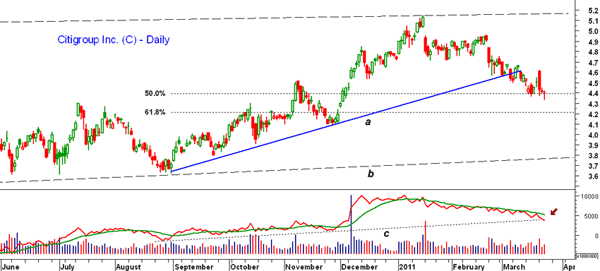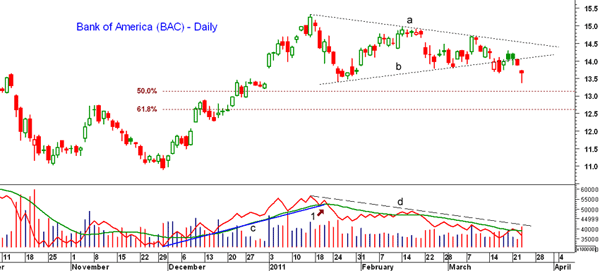Banking giants Bank of America and Citigroup are in the news again this week, but a closer look shows why investors should now be more cautious than ever about owning the shares.
The surprise announcement of the reverse ten-to-one stock split by Citigroup (C) and the rejection of Bank of America’s (BAC) proposal to raise its dividend reinforces the negative technical outlook for these two big banks. On February 28, I focused on the deteriorating technical outlook for these two banks, and Citigroup is now 5.9% lower while Bank of America has lost 4.4%.
The decision by Citigroup certainly makes me wonder how confident their management team is about future earning prospects, as it seems like a desperation move. And while I hope this is one of the reverse stock splits that result in higher prices for stockholders, I remember times when it has not.
After the 2007 decision by Sun Microsystems for a one-to-four reverse split, shares ended up losing 80% of their value in following year before eventually being acquired by Oracle (ORCL). It will take some time to see whether the split will result in more institutional ownership of Citigroup shares, but as an individual investor, I would not be happy to get 20 shares for the 200 I had originally purchased. The Federal Reserve’s rejection of Bank of America’s plan to modestly raise its dividend also does not help investor confidence in BAC, so both banks could be hit by further selling.
Chart Analysis: Citigroup (C) closed below its uptrend, line a, on March 4, and has now declined to the 50% retracement support at $4.39.
- The 61.8% retracement support is at $4.20 with additional chart support in the $4-$4.10 area. Critical long-term support is in the $3.80 area (line b), and if it is broken, that would have very negative implications
- The weekly on-balance volume (OBV-not shown) dropped below its weighted moving average (WMA) two weeks ago, and the daily OBV has been drifting lower for the past two months. The OBV has just broken its uptrend, line c
- The first resistance levels to watch are at $4.60 and then $4.68. It would take a close back above $4.68 to stabilize the daily chart. Much more important resistance is in the $4.96-$5.00 area
Bank of America (BAC) completed the triangle formation on the daily chart (lines a and b) last week before the Fed’s announcement.
- The 38.2% support level has also been broken with the 50% support at $13.13. A close below $13.00 would likely add more selling pressure that could take BAC to the 61.8% support at $12.63
- The daily OBV dropped below its weighted moving average and support (line c) on January 21, point 1. The OBV is in a well-defined downtrend with lower lows and lower highs, line d
- The weekly OBV (not shown) is also below its weighted moving average and is likely to violate support this week
- There is first resistance in the $14-$14.30 area, which must be overcome to stabilize the short-term outlook
- A daily close above the March 8 highs at $14.70 would be the first strong sign that the correction was over
What It Means: The stock market is acting very well and Wednesday’s rebound after early selling was impressive. Another higher close today will suggest that we did form a panic low last week. Nevertheless, the failure of the financial sector to participate still has me concerned. The chart of the Financial Select Spyder (XLF–not shown) does look much better, as do the charts of some of the regional banks. The key resistance level to watch for XLF is at $16.60 with important support at $15.79.
How to Profit: Even though it is possible that the decline from the February highs is now ending, the poor relative performance of both C and BAC suggests they do not deserve a place in your portfolio. One group that looks strong from a seasonal perspective is the Transports, and this week’s Trading Lessons e-letter, to be released this afternoon, features five stocks that look much better technically than these two banks. Sign up for Trading Lessons here.



















